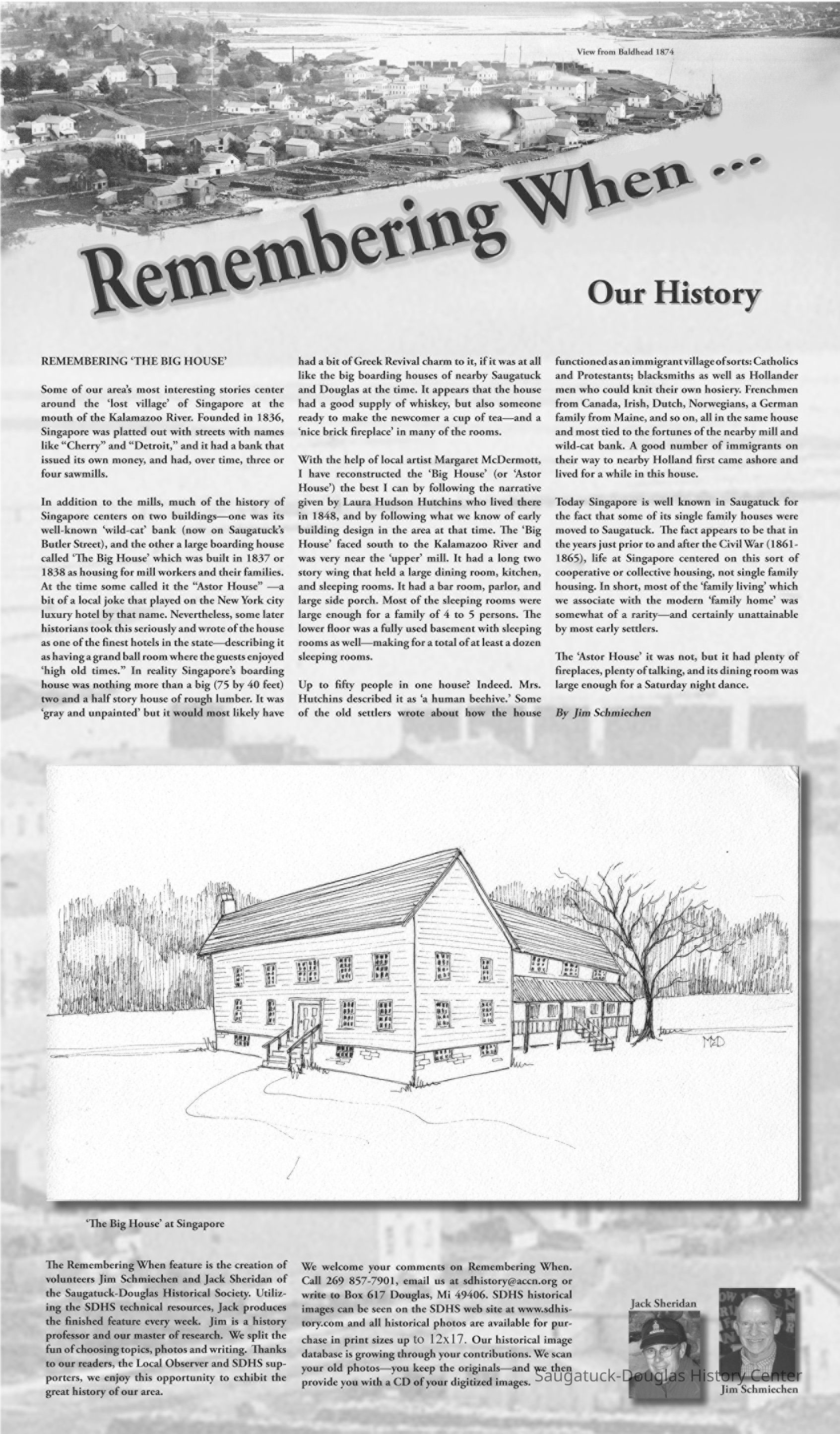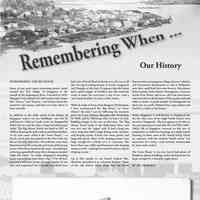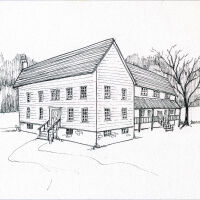Singapore Big House or Astor House

2021.87.114
REMEMBERING ‘THE BIG HOUSE’ Some of our area's most interesting stories center around the 'lost village' of Singapore at the mouth of the Kalamazoo River. Founded in 1836, Singapore was platted out with streets with names like "Cherry" and "Detroit," and it had a bank that issued its own money, and had, over time, three or four sawmills. In addition to the mills, much of the history of Singapore centers on two buildings — one was its well-known "wild-cat" bank (now on Saugatuck's Butler Street), and the other a large boarding house called 'The Big House' which was built in 1837 or 1838 as housing for mill workers and their families. At the time some called it the "Astor House" — a bit of a local joke that played on the New York city luxury hotel by that name. Nevertheless, some later historian took this seriously and wrote of the house as one of the finest hotels in the state — describing it as having a grand ball room where the guests enjoyed 'high old times." In reality Singapore's boarding house was nothing more than a big (75 by 40 feet) two and a half story house of rough lumber. It was 'gray and unpainted' but it would most likely have had a bit of Greek Revival charm to it, if it was at all like the big boarding houses of nearby Saugatuck and Douglas at the time. It appears that the house had a good supply of whiskey, but also someone ready to make the newcomer a cup of tea — and a 'nice brick fireplace' in many of the rooms. With the help of local artist Margaret McDermott, I have constructed the 'Big House' (or Aster House) the best I can by following the narrative given by Laura Hudson Hutchins who lived there in 1848, and by following what we know of early building design in the are at that time. The Big House faced south to the Kalamazoo River and was very near the upper mill. It had a long two story wing that held a large dining room, kitchen, and sleeping rooms. It had a bar room, parlour, and large side porch. Most of the sleeping rooms were large enough for a family of 4 to 5 persons. The lower floor was fully used basement with sleeping rooms as well — making for a total of at least a dozen sleeping rooms. Up to fifty people in one house? Indeed. Mrs. Hutchins described it as a 'human beehive.' Some of the old settlers wrote about how the house functioned as an immigrant village of sorts: Catholics and Protestants; blacksmiths as well as Hollander men who could knit their own hosiery. Frenchmen from Canada, Irish, Dutch, Norwegians, a German family from Maine, and so on, all in the same house and most tied to the fortunes of the nearby mill and wild-cat bank. A good number of immigrants on their way to nearby Holland first came ashore and lived for a while in this house. Today Singapore is well known in Saugatuck for the fact that some of its single family houses were moved to Saugatuck. The fact appears to be that in the years just prior to and after the Civil War (1861-1865), life at Singapore centered on this sort of cooperative or collective housing, not single family housing. In short, most of the 'family living' which we associate with the modern 'family home' was somewhat of a rarity — and certainly unattainable by most early settlers. The Astor House it was not, but it had plenty of fireplaces, plenty of talking, and its dining room was large enough for a Saturday night dance.
Remembering When
Winthers, Sally
Digital data in CatalogIt
Sheridan, John "Jack" O. 1938-McDermott, MargaretSchmiechen, James A.
Singapore, Michigan 1837-1875
Local Observer
The Big House at Singapore by James Schmiechen The recent Historical Society book and exhibit "Lost and Found: Ghost Towns of the Saugatuck Area, " has generated a renewed interest in the "lost" village of Singapore which was located near what is now the mouth of the Saugatuck harbor. From the time the first sawmill was established in 1838 until the last mill was closed in 1875, Singapore was a boom-and-bust settlement, subject to capital shortages, fires, changing ownership, and, finally, a dwindling supply of local white pine trees. People came and went. Indeed, it appears that Singapore was a stopping off point for immigrants from eastern United States and Europe-often coming by way of Chicago. Looking for work and shelter (and land), these were people who did not have the means to purchase land when they arrived. Local historian May Heath suggested that 200 people lived at Singapore, but more recently James Sheridan claims that there were probably only about 50 people at any one time in the little settlement. May Heath's book, Early Memories of Saugatuck, is full of references to local heroes (men and women) who started out at Singapore and then moved to Saugatuck. Henry Hudson Hutchins' account of his family (printed in Western Allegan County Pioneer Days) includes some interesting references to everyday life in Singapore. For the most part, however, much of everyday life over a century ago in Singapore is really "lost." The most visible Singapore artifacts for us today are a number of interesting old houses which were moved up-river from old Singapore to Saugatuck. One way to get a new angle on Singapore life is to look at its most celebrated (and controversial) building: the big boarding house-hotel, sometimes called "The Astor House," which was built in 183? or 1838, as housing for mill employees (and at one time even the mill owner, Mr. Carter). It appears that although the name "Astor House" was used at the time as a bit of a local joke--a play on the New York hotel by that name which was the epitome of luxury--it was later picked up by historians as being actual fact. Writing in the 1920s, May Heath called it one of the finest hotels in the state-a reference she probably got from an Allegan newspaper of the 1870s which referred to the "high old times" the early settlers had dancing in the hotel's "commodious ball room." My guess is that by the time this story of a grand hotel at Singapore was passed around, the structure was long gone--probably destroyed by the same fire which destroyed the main mill in 1866. In reality the Singapore "Astor House" hotel was, as Henry Hutchins' mother Laura tells us, nothing more than a big (60 by 40 feet) three-story boarding house made of rough lumber--although it might have had a bit of charm to it if it was at all like the big boarding houses in Saugatuck and Douglas at the time (see the photos of the Douglas House and the Judson-Heath House on pages 7-8 of Raising the Roof). The lower floor was a fully exposed basement constructed of brick. It faced south to the Kalamazoo River not too far from where the harbor entrance sea wall begins and had a long two story wing (or "L") with a porch, at the rear, facing east. A bar room and parlor occupied the main floor front, with adjacent "sitting rooms," a large dining room, and kitchen hall in the back wing. It appears to have had at least a dozen sleeping rooms, most large enough to house an entire family. Up to fifty people in one house? Indeed, what is of additional historic interest about this "Big House" at Singapore is how it functioned as an immigrant village: Frenchmen from Canada, Irish, Dutch, Norwegians, a German family from Maine, and so on, all in the same house, all eating in the same dining room, and all tied to the same fortunes of the nearby mill and wild-cat bank. Our reconstruction of the "Big House" also reminds us that, as in nearby Saugatuck and Douglas at the same time and probably up to the time of the Civil War, most families and individuals did not live as single-family units in single family dwellings. Instead, most people lived in this sort of boarding house where religion, occupation, and ethnic origins mixed, and where privacy and space for individual and family-centered activity was limited. Evidence suggests that most of the single-family houses a1 Singapore were built later, in the years just prior to and after the Civil War (1861-1865), and eves after this time Singapore still had a boarding house for its mill workers. In short, the sort of "family living" and "family life" which we associate with the modern "family home" was somewhat of a rarity and certainly unattainable by most early settlers. What I have done below is reconstruct the "Big House" as best I can by following the narrative given by Laura Hudson Hutchins who lived there in 1848, and who described it to her son, Henry Hudson Hutchins, and by following what we know of early building design in the area at that time. The "Astor House" it was not, but its dining room was large enough for a Saturday night dance-and it certainly had great views from all rooms. Source: SDHS newsletter insert pages 179-180
12/25/2022
11/25/2023



![The Big House at Singapore (Ca. 1838-1866); Function: company boarding house for mill workers Size: 75' x 50' according to 1856 survey. [Hutchins says 70' x 60'] Construction: unknown. Probably post and beam. Rough wood plank and brick lower level. Site: front facing south to Kalamazoo River about 125' from the](https://d3f1jyudfg58oi.cloudfront.net/4124/image/c0df7270-8b83-11ee-ab4c-c373f3aa0796-uXCtBWt.tn.jpg)